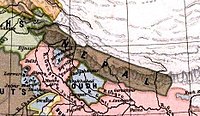| 1951 Nepalese Revolution | |||||||
|---|---|---|---|---|---|---|---|
| Part of the Nepalese democracy movement | |||||||
 Leading figures of the Nepali Congress and King Tribhuvan | |||||||
| |||||||
| Belligerents | |||||||
| Rana dynasty | Nepali Congress | ||||||
| Commanders and leaders | |||||||
| Mohan Shumsher | Nepali Congress leader | ||||||
| Casualties and losses | |||||||
|
Military dead: 1600 |
Military dead: 900 | ||||||
| History of Nepal |
|---|
 |
|
|
The revolution of 1951 (Nepali: सात सालको क्रान्ति, romanized: Sāta Sālako Krānti) in Nepal, also referred to as Sat Salko Kranti, was a political movement against the direct rule by the Rana dynasty of Nepal which had lasted for 104 years. It marks the beginning of the political awakening and democratic movements in Nepal, and resulted in immediate abolition of the institutionalized hereditary Prime Minister system in Nepal.